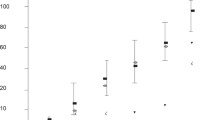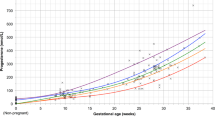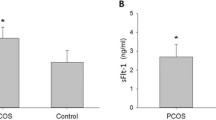Summary
Pregnancy-associated plasma protein-A (PAPP-A) is a macromolecular glycoprotein produced in increasing concentration as pregnancy advances. PAPP-A is not specific to pregnancy since measurable levels have been found in non-pregnant females and in males. In non-pregnant females, PAPP-A is probabely produced by the endometrium. The origin of PAPP-A in pregnant women is still controversial. In-vitro trophoblast and decidual explants both produce PAPP-A. So far, it is not known if the same applies to the in-vivo situation and to what extent these two tissues contribute to the circulating levels of PAPP-A.
This study compares the circulating concentrations of PAPP-A and β-hCG and progesterone in different pathological situations. In hydatidiform moles, β-hCG levels are very high demonstrating an intense trophoblastic activity, whereas PAPP-A levels remain in the normal range. With spontaneous abortions, β-hCG levels decline to very low values whereas PAPP-A continues to increase. These observations furnish indirect evidence for a major contribution to circulating PAPP-A levels by extratrophoblastic sites. Furthermore, PAPP-A levels decrease after administration of an antiprogesterone (RU486) either in-vivo or in-vitro. This is considered as a proof that PAPP-A levels in early pregnancy are progesterone dependent.
Similar content being viewed by others
References
Bischof P, Haenggeli L, Sizonenko MT, Herrmann WL, Sizonenko PC (1981) A radioimmunoassay for the measurement of pregnancy-associated plasma protein-A (PAPP-A) in humans. Biol Reprod 24: 1076–1081
Bischof P, DuBerg S, Schindler AM, Obradovich D, Weil A, Faigaux R, Hermann WL, Sizonenko PC (1982) Endometrial and plasma concentrations of pregnancy-associated plasma protein-A (PAPP-A). Br J Obstet Gynaecol 89: 701–703
Bischof P, DuBerg S, Herrmann WL, Sizonenko PC (1982) Amniotic fluid and circulating levels of pregnancy-associated plasma protein-A (PAPP-A) throughout pregnancy. Comparison with other foeto-placental products. Br J Obstet Gynaecol 89: 358–363
Bischof P, Martin-du-Pan R, Lauber K, Girard JP, Herrmann WL, Sizonenko PC (1983) Human seminal plasma contains a protein that shares physicochemical, immunochemical and immunosuppressive properties with pregnancy-associated plasma protein-A (PAPP-A). J Clin Endocrinol Metab 56: 359–362
Bischof P, DuBerg S, Sizonenko MT, Schindler AM, Beguin F, Herrmann WL, Sizonenko PC (1984) In-vitro production of pregnancy-associated plasma protein-A by human decidua and trophoblast. Am J Obstet Gynecol 148: 13–19
Bischof P, Schindler AM, Urner F, Mensi N, Herrmann WL, Sizonenko PC (1984) Pregnancy-associated plasma protein-A (PAPP-A) concentration in uterine fluid and immunohistochemical localization in the endometrium. Br J Obstet Gynaecol 91: 863–869
Bischof P, Amaudruz M, Weil-Franck C, Baeriswyl JP, Weil A, Herrmann WL, Sizonenko PC (1984) The disappearance rate of pregnancy-associated plasma protein-A (PAPP-A) in normal and abnormal pregnancies. Arch Gynecol 236: 93–99
DuBerg S, Bischof P, Schindler AM, Béguin F, Herrmann WL, Sizonenko PC (1982) Tissue and plasma concentrations of pregnancy-associated plasma protein-A (PAPP-A). Comparison with other foeto-placental products. Br J Obstet Gynaecol 89: 352–357
Grudzinskas JG, Gordon YB, Obiekwe BC, Pendlebury B, Chard T (1980) Detection of circulating placental protein-5 in patients with trophoblastic tumors. Am J Obstet Gynecol 137: 866–867
Herrmann WL, Wyss R, Riondel A, Philibert D, Teutsch G, Salik E, Baulieu EE (1982) Effet d'un stéroïde anti-progestérone chez la femme: interruption du cycle menstruel et de la grossesse au début. CR Acad Sci Paris 249: 933–938
Lin TM, Halbert SP, Kiefer D, Spellacy WN (1974) Three pregnancy-associated human plasma proteins: purification monospecific antisera and immunological identifications. Int Arch Allergy Appl Immunol 47: 35–53
Lin TM, Halbert SP (1976) Placental localization of human pregnancy-associated plasma proteins. Science 193: 1249–1252
Rosen SW (1975) Placental proteins and their subunits as tumor marker. Am J Internal Med 82: 71–80
Schindler AM, Bordignon P, Bischof P (1984) Immunohistochemical localization of pregnancy-associated plasma protein-A (PAPP-A) in decidua and trophoblast. Comparison with hCG and fibrin. Placenta 5: 227–236
Sinosich MJ, Smith DH, Grudzinskas JG, Saunders DM, Westergaard JG, Teisner B (1983) The prediction of pregnancy failure by measurement of pregnancy-associated plasma protein-A. Fertil Steril 40: 539–541
Sjöberg J, Wahlström T, Seppälä M (1984) Pregnancy-associated plasma protein-A in the human endometrium is dependent on the effect of progesterone. J Clin Endocrinol Metab 58: 359–362
Wahlström T, Teisner B, Folkersen J (1981) Tissue localization of pregnancy-associated plasma protein-A (PAPP-A) in normal placenta. Placenta 2: 253–258
Author information
Authors and Affiliations
Rights and permissions
About this article
Cite this article
Bischof, P., Schindler, A.M., Wyss, R. et al. Progesterone dependence and extratrophoblastic origin of pregnancy-associated plasma protein-A (PAPP-A) in early pregnancy. Arch. Gynecol. 237, 109–116 (1986). https://doi.org/10.1007/BF02133854
Received:
Accepted:
Issue Date:
DOI: https://doi.org/10.1007/BF02133854




